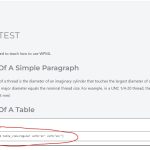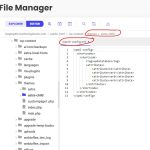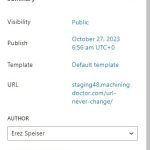This is the technical support forum for WPML - the multilingual WordPress plugin.
Everyone can read, but only WPML clients can post here. WPML team is replying on the forum 6 days per week, 22 hours per day.
Tagged: Documentation request
This topic contains 13 replies, has 2 voices.
Last updated by Mateus Getulio 1 year, 6 months ago.
Assisted by: Mateus Getulio.
| Author | Posts |
|---|---|
| November 13, 2023 at 5:28 am #14785337 | |
|
erezS-3 |
1) I have jobs of published pages that are in a "need update" status because I have made small modifications on the source page. 2) Also, the "need update" jobs are automatically assigned to the translator of that page. How can I reassign an update request to a different translator? Thanks |
| November 13, 2023 at 8:32 pm #14792197 | |
|
Mateus Getulio Supporter
Languages: English (English ) Portuguese (Brazil) (Português ) Timezone: America/Sao_Paulo (GMT-03:00) |
Hi there, Thanks for your contact! Answering the questions: 1) I have jobs of published pages that are in a "need update" status because I have made small modifications on the source page. This is the expected behavior, whenever there's an update on the default language, that status will show up for the translations to make sure that you don't miss to also update the translations, in case that's necessary. You could just open the translation, re-save and finish it, without changes. If you don't want that to happen nor update the translation, before changing and saving the default language post you can enable the option "minor edit don't update translation" in the 'Publish' meta-box - please check the screenshot: hidden link 2) Also, the "need update" jobs are automatically assigned to the translator of that page. How can I reassign an update request to a different translator? You can do that by: - going to WPML -> Translation Management Kindly check our related doc: https://wpml.org/documentation/translating-your-contents/how-to-set-up-local-translators-and-language-pairs/#submitting-translation-jobs-to-local-translators Please let me know if the info above helps you, and solves the issues. Thank you. Kind regards, |
| November 14, 2023 at 7:18 am #14793821 | |
|
erezS-3 |
Hello Mateus, Very helpful information. Thanks! There is one scenario that I am still unsure how to handle: Thanks, |
| November 14, 2023 at 4:33 pm #14800859 | |
|
Mateus Getulio Supporter
Languages: English (English ) Portuguese (Brazil) (Português ) Timezone: America/Sao_Paulo (GMT-03:00) |
Hello Erez, Thanks for your reply. Please avoid to switch between the Translation Editors (manual and ATE), because it may result in the issue you just described. If you want to use the manual editor for a specific translation, you should keep using it, and not use ATE anymore for that translation - besides this, you need to make sure the 'WordPress Editor' is enabled on the 'Language' metabox: hidden link Manual changes made on the translations can be lost when you do not follow this procedure. I kindly ask you to fully read and review this another documentation: https://wpml.org/documentation/translating-your-contents/using-different-translation-editors-for-different-pages/ - it will teach you how to keep track of the manual translations. It should be solved after these steps. Please let me know if you still need further assistance. Thank you, |
| November 14, 2023 at 4:59 pm #14801045 | |
|
erezS-3 |
I think you did not write the correct URL for the "another documentation:" |
| November 14, 2023 at 5:05 pm #14801149 | |
|
Mateus Getulio Supporter
Languages: English (English ) Portuguese (Brazil) (Português ) Timezone: America/Sao_Paulo (GMT-03:00) |
Hi Erez, Sorry about that, I have already corrected it, please take a look. Waiting for your feedback. Thanks |
| November 14, 2023 at 5:39 pm #14801307 | |
|
erezS-3 |
Hi, Very helpful article. I understand the logic. For clear-cut cases, I know what to di. I translated pages with the advanced translation editor. Question: 2) What is the best procedure to follow in such cases, where I must do some manual editing, but most of the content can still be translated the regular way? 3) In my typical cases, the things I need to modify manually are inside the "HTML" and "Shortcode" Guttenberg blocks. Is there a way to get them inside the translation editor? Thanks! |
| November 14, 2023 at 7:54 pm #14802159 | |
|
Mateus Getulio Supporter
Languages: English (English ) Portuguese (Brazil) (Português ) Timezone: America/Sao_Paulo (GMT-03:00) |
Hello Erez, Thanks for your reply. Even if the post was already translated using ATE, you still need to enable the 'WordPress Editor' here: hidden link, if you're going to do manual changes on the translated post. Regarding the new questions you brought: 1) As long as I don't go again into the translation editor, will the translated page remain as it is, or will the WPML automatically revert it back to the version of the translation editor? It should stay the way as it is, but we can't guarantee that it'll work smoothly if you do not enable the WordPress editor as I mentioned above. 2) What is the best procedure to follow in such cases, where I must do some manual editing, but most of the content can still be translated the regular way? We do not recommend to switch between the Translation Editors like this because you will run at the risk of having your translations overwritten. 3) In my typical cases, the things I need to modify manually are inside the "HTML" and "Shortcode" Guttenberg blocks. Is there a way to get them inside the translation editor? Yes, there is a way. We have an excellent article explaining how you can do that, please check it: https://wpml.org/faq/how-to-translate-urls-shortcodes-and-html-attributes-using-the-advanced-translation-editor/ I hope that everything is clear now, please let me know. Thanks in advance! |
| November 15, 2023 at 3:58 pm #14811239 | |
|
erezS-3 |
Hi, 1) Regarding this panel: hidden link - Can I set it separately for each language? 6) the ATE still does not show the shortcode for translation. Please help to fix these issues. Thanks! |
| November 16, 2023 at 4:41 pm #14829313 | |
|
Mateus Getulio Supporter
Languages: English (English ) Portuguese (Brazil) (Português ) Timezone: America/Sao_Paulo (GMT-03:00) |
Hi Erez, Thanks for your reply. 1) Regarding this panel: hidden link - Can I set it separately for each language? You can, but it is necessary to do the action just once, and in the original language content. 2) Regarding this panel: hidden link - I don't see the checkbox "Minor edits" on my website. I checked both the Gutember and classic editors, and it is missing from both. (See attached image) Please make sure to look for it in the 'language' meta-box, not in the 'summary' one. I have just checked in a clean WP install, for both Classic and Gutenberg editors, and it is working fine. If the problem remains, it might be due to a plugin/theme conflict, and we would need to check it better. 3) the ATE still does not show the shortcode for translation. Could you please try this XML code instead? Just remove the previous one, and add it in the WPML -> Settings -> Custom XML Configuration tab:
<wpml-config>
<shortcodes>
<shortcode>
<tag>wpdatatable</tag>
<attributes>
<attribute>id</attribute>
<attribute>var8</attribute>
<attribute>var9</attribute>
</attributes>
</shortcode>
</shortcodes>
</wpml-config>
You will need to do a small modification to the original language content, and then update the translation. It's also a good idea to clear any caching mechanisms. This includes browser cache, any caching plugins you might have installed, or server-side caching. Regardless, if you still face problems with the shortcode translation, may I kindly ask you to open a different ticket or chat for this new issue? Since the main subject of this topic is the translations update, and our support policy does not allow more than one issue per ticket/chat. This will also help other users with similar problems find solutions when searching the forum as well as we avoid mixing lots of questions in one ticket. Thank you for your understanding. Kind regards, |
| November 17, 2023 at 11:39 am #14861711 | |
|
erezS-3 |
Hi, 1) You can, but it is necessary to do the action just once, and in the original language content. I don't understand exactly how to do it. Could you please provide more details? 2) Please make sure to look for it in the 'language' meta-box, not in the 'summary' one. I have just checked in a clean WP install, for both Classic and Gutenberg editors, and it is working fine. It's ok now! 3) XML - Still does not work. But it is less urgent. I will investigate deeper, and if needed open a new ticket. Thanks, |
| November 17, 2023 at 8:45 pm #14866183 | |
|
Mateus Getulio Supporter
Languages: English (English ) Portuguese (Brazil) (Português ) Timezone: America/Sao_Paulo (GMT-03:00) |
Hello there, Sure thing. When you translate the page using ATE, and later need to do manual adjustments into the translations, it is necessary to enable the WordPress Editor, and not use ATE anymore for that particular page. You should do this by going to the original language post, and enabling this option I mentioned previously: hidden link Then, you're safe to open the translations and do all the changes you need to do. I have exemplified it in this video, kindly check it: hidden link Please let me know if it is clearer now. Thank you! |
| November 20, 2023 at 7:30 am #14873395 | |
|
erezS-3 |
Hi, How do I differentiate between the languages? Thanks, |
| November 20, 2023 at 3:36 pm #14879045 | |
|
Mateus Getulio Supporter
Languages: English (English ) Portuguese (Brazil) (Português ) Timezone: America/Sao_Paulo (GMT-03:00) |
Hi there, Thanks for your reply. WPML generally uses the same editing interface for all translations of a specific page. If you choose to use ATE for a translation, that choice will apply to all languages associated with that page. If you need to do manual adjustments to a particular translation (for example, the Spanish translation), you will need to make these changes in the default WordPress editing interface, but this will affect all languages as well. Our recommendation is to choose one translation editor and stick to it. If one translation requires significant manual adjustments and you want the translations for other languages to remain in ATE, you may need to consider an alternative workflow. For instance, you could: 1 - enable the WordPress editor just for a moment, in order to do the manual changes, and when you're done, enable the WPML Translation Editor back, so that your translators can translate using ATE; 2 - or you can ask them to always use the WordPress Editor to do the translations; 3 - another option would be to wait until the translators finish all the translations, and then switch the translation editor to the manual one; We cannot guarantee that it'll work smoothly. As mentioned previously, switch between the editors might lead to problems, specially overwriting ones. Please check these similar threads and the explanations my colleagues provided: - https://wpml.org/forums/topic/yoast-faqs-block-corrupts/ I'm afraid that in this scenario the workarounds we can provide are the ones I mentioned above. Please be cautious if you're going to try them and make sure to have a complete backup. Kind regards, |
| November 20, 2023 at 4:18 pm #14879427 | |
|
erezS-3 |
It is all clear now. Thanks! |



